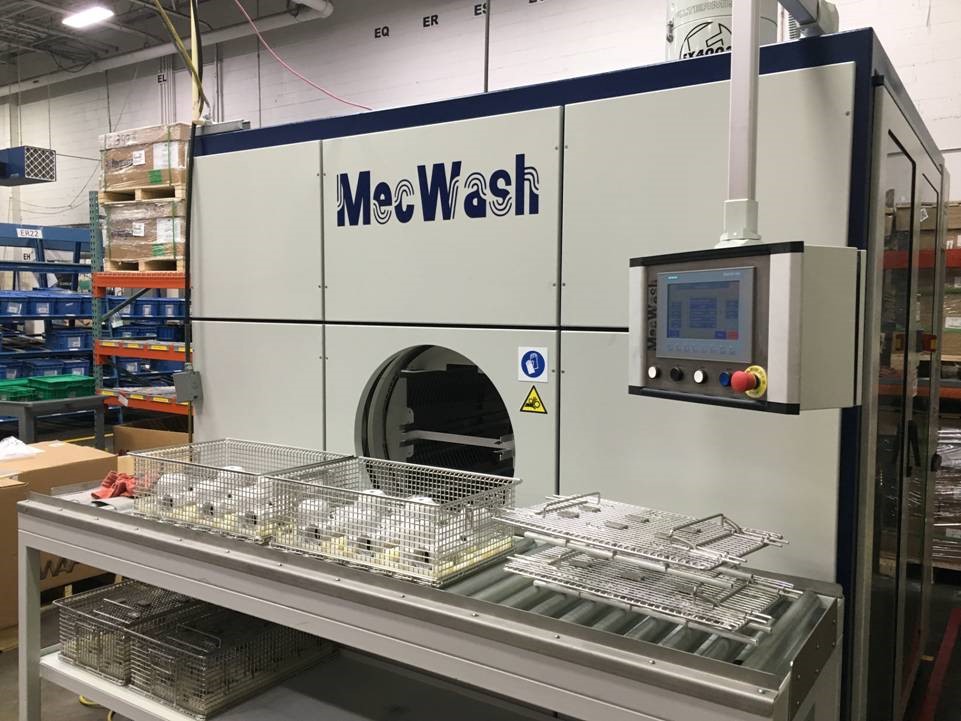 The MecWash MWX at Parker Hannifin Hydraulic Pump and Power Systems, located in New Hope, Minnesota.
The MecWash MWX at Parker Hannifin Hydraulic Pump and Power Systems, located in New Hope, Minnesota.MecWash's North American operations manager, Bill Westbrook, talks about the benefits of aqueous-based cleaning systems.
Leading engineers recognize the benefits of cleaning machined parts in aqueous-based systems. Water-based cleaning can achieve exceptional levels of cleanliness using chemicals that do not harm the environment. Water-based systems are also inexpensive to maintain. Both the cost of the equipment and the aqueous cleaning chemical used within it tend to be much less expensive than the cost of solvent systems and the solvents used within them.
A lot of manufacturers believed and maybe still believe that aqueous cleaning is fine for cleaning parts of coolant and other water-soluble contamination, but that only solvents can remove cutting oil, grease, or paraffin. This is not true. High-performance aqueous cleaning systems that employ the correct combination of process, temperature, and chemical can clean a vast range of parts as well as or better than solvent systems.
Another erroneous legacy belief is that parts made from ferrous metals must be cleaned in solvents to prevent flash rusting. This also is not true. Aqueous chemical formulations are sophisticated and able to provide rust inhibition both during the cleaning process and for a significant length of time after it, should the parts in question be required to sit in inventory for a period of time.
For those companies that still use solvents to clean parts, these solvent processes can be seemingly ‘grandfathered’ into a company’s operating procedure. It is often the case that a given company started cleaning with solvents decades ago, back before aqueous cleaning made its many advances in cleaning performance. Change is seen as high risk, but in reality, it is the status quo that brings risks to the business.
Consider what is happening in this country. With each passing year, more and more solvents employed in vapor degreasing are falling under the review of the United States Environmental Protection Agency (EPA). Many of these solvents have been found to pose unreasonable risks to workers in manufacturing environments who have both direct exposure (i.e. workers manning parts cleaning stations) and indirect exposure (i.e. workers in proximity to parts cleaning stations).
Under the Toxic Substance Control Act (TSCA), the EPA is reviewing the use of trichloroethylene (TCE), trans-dichloroeythylene, perchloroethylene, methylene chloride, and n-propyl bromide. Many of these chemicals are carcinogenic; they are toxic for the central nervous system, the kidneys, the liver, the lungs, and the reproductive system. Long have they been regulated for their emissions. Now, the consensus under the Biden Administration is that TSCA review of these and other chemicals will increase and that the burden of their use will become ever more onerous as these regulations become more strict.
On the state level, in 2020, Minnesota became the first state to outlaw the use of TCE in industrial and commercial applications altogether. Signed into law on May 16, 2020, the total ban on TCE begins on June 1, 2022. Elsewhere, New York has a bill pending in its Senate Environmental Conservation Committee that would prohibit the use of TCE as a vapor degreasing solvent, an additive to produce other chemicals, a refrigerant, an extraction solvent, or as a solvent for use in any other manufacturing process. If passed as presently written, the bill would take effect in New York immediately. Again, the consensus is that other states will follow these two in tightening, and even outright banning, the use of a number of solvents in industrial applications.
The answer to these myriad solvent regulations is not to try to stay one step ahead of the EPA, hopping from one solvent to another. The answer is to go aqueous. At MecWash Systems, many of our customers have moved completely away from solvent cleaning and now depend on our aqueous equipment to clean both their ferrous and non-ferrous parts of oil-based and water-soluble contamination.
For example, Husco International, a major manufacturer of automotive and off-highway hydraulic components, has purchased more than a dozen MecWash machines to clean numerous different cast iron part designs at their manufacturing facilities in the US, the UK, and China. The same is true for Woodward, which cleans cast iron pump housings and their associated parts in extended chamber MecWash machines in their Loveland, Colorado facility as well as in Germany.
For so many applications, high-performance, water-based cleaning is the optimal method to clean a full range of parts to a very high degree of cleanliness. Our systems are relied on for countless aerospace, medical, hydraulic, and automotive applications. What’s more, when you clean with water, you never need to worry about government regulators, fire department inspectors, or in-house EH&S managers crawling down your back. So, why bother with the liabilities and expense of solvents when cleaning with water can produce excellent cleanliness results without the regulatory hassle or risks to your workforce?
Talk to us at MecWash Systems. Depending on your throughput requirements, our answer to solvent replacement are three systems: the high-performance aqueous MecWash MWX, Maxi and AVD.
Further information on these machines can be found here: https://www.mecwash.com/products/mwx-maxi-avd/